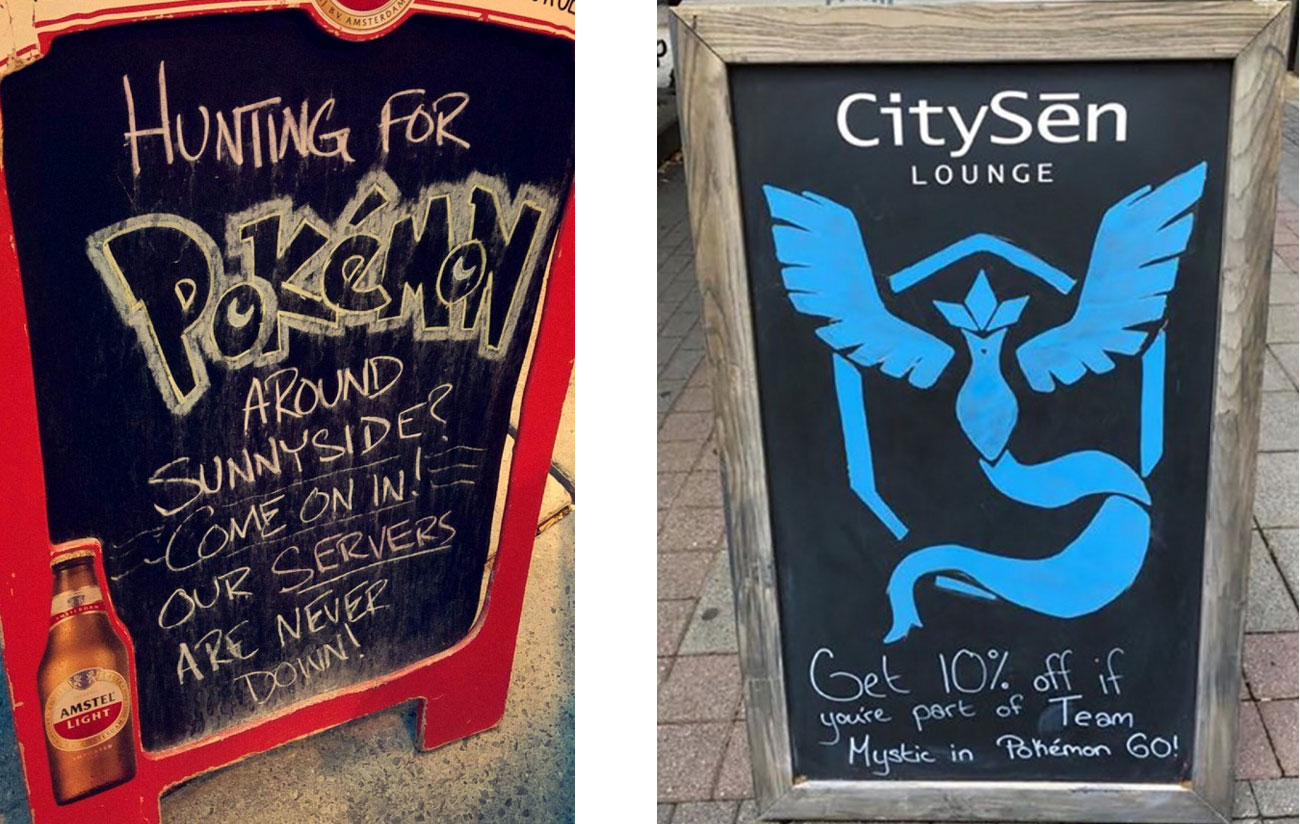July 6, 2016 will be remembered as a fateful day in the marketing world. July 6 is when Nintendo, game maker Niantic Labs (a Google spin-off) and The Pokémon Company released a new augmented reality (AR) game called Pokémon Go which brings the game of Pokémon to life in the real world via a mobile app. The engagement created by this game is phenomenal and, as marketers, our heads should be spinning with brand, promotional and monetization opportunities!
The app itself is a free download but it offers in-app purchases for additional items and “power-ups”. As users build their Pokémon inventory, spending money improves their ability to store, train, battle and lure Pokémon. Currently, there are no paid ads or product placements or obviously promoted places in the app…yet. Players can see Pokémon, PokéStops and PokéGyms via GPS on their phone and see the actual Pokémon themselves in the real world through their phone’s camera, do battle and capture them.
This has lured many typically introverted gamers out of their houses, apartments, dorms and work places to places they may not have visited or enjoyed visiting before; getting exercise they would not have sought otherwise and meeting people they certainly would never have met before.
My family provides a great example. The day after Pokémon Go launched, my daughter, who already downloaded the app, went outside during lunch at her internship to take advantage of a lure some other player had dropped and met other college students she would no doubt never have met. Last weekend, we were at Universal Studios Hollywood and my kids had the game open on their phones (which made waiting in lines a lot less tedious!). Four days after the launch, ride operators already knew about the game and gave tips on Pokémon lurking in certain places around the park or where gyms were located. Now there are entire crowds playing the game together at shopping malls and other public spaces. Poké nerds new and old unite!
Huge Opportunity
Right now, this phenomenon is organic and authentic, just like brand marketers prefer. But can this last? Currently, where players find the most valuable Pokémon, PokéStops and gyms seems somewhat random. Nevertheless, enterprising restaurants and retailers already see huge potential and are leveraging the game to generate foot traffic (see below).

Already, articles abound about how agencies are being tasked with finding a Pokémon Go solution. Everyone is trying to tap into the rapidly growing mobile-gaming market, projected to be $36 billion by the end of 2016. Right now, most mobile games are free to play, but according to research firm Super Data, Pokémon Go grossed $14.4 million of in-game purchase in the first 5 days! Ka-ching!
Gamers can be fickle, but Pokémon Go has proven, in a short time, that in-game purchases can drive revenue. The secret? A fun brand experience that drives engagement. The app has become one of the most popular in the world and key to its viral success is the fact that the app has a “Picture Mode” which allows its users to capture Pokémon on camera which they can then share on social media. This engaging user generated content helps to effortlessly promote the game. According to Similar Web, in the first week, Pokémon Go users have spent more time playing the game than using Instagram, Snapchat or Facebook Messenger.
Nevertheless, the temptation for Niantic Labs, Nintendo and Pokémon to make promotional deals to attract gamers to certain locations will be huge. This is where marketers must proceed with caution. Making the game too promotional runs the risk of ruining the game and killing the game’s nascent loyal following. If the game’s creators choose to go down a more promotional path, they need to carefully to balance authenticity and engagement. Don’t kill the potential golden goose too soon.
New Rules of Engagement
From our perspective, Pokémon Go truly expands the definition of brand engagement. It promotes live discussions, real time information sharing and collaborative exchanges. It encourages engagement in a way never before seen and something marketers have not been as successful at fostering in the past. Is this a unique phenomenon or a new model?
Revitalizing Brands
Pokémon and Nintendo have been tied together for a long time. Their fortunes have grown and waned over the years. Since 2012, Nintendo’s revenue has declined as it resisted entering the mobile gaming market and a previous entry in mobile gaming was unsuccessful.
Pokémon, launched in Japan in 1996, has been more successful. It is one of the world’s most popular children’s entertainment franchises. The brand is distributed across many platforms including toys, video games,anime, movies, trading cards, manga’s, music and even a musical. While many of these platforms helped the brand grow, none of these might be as much of a game changer as the new Pokémon Go mobile app.
So far the market agrees. In the last 10 days, Nintendo’s share price has increased a staggering 50%, adding nearly $15 billion in market value. Certainly this new live version of Pokémon has infused much welcomed energy into both Pokémon and, especially, the Nintendo brand.
Now it remains to be seen if whether the buzz can be sustained. Is this a summer fling or does the Pokémon Go model alter the marketing landscape? Marketers will watch closely to see if the app versions of Animal Crossing and Fire Emblem will lend themselves similarly to such viral success but certainly today, the Pokémon brand’s future looks as bright as a Jolteon.



Recent Comments